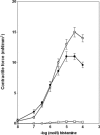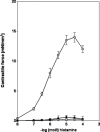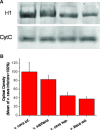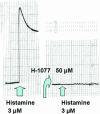Histamine and H1 -histamine receptors faster venous circulation
- PMID: 21199332
- PMCID: PMC4373430
- DOI: 10.1111/j.1582-4934.2010.01254.x
Histamine and H1 -histamine receptors faster venous circulation
Abstract
The study has analysed the action of histamine in the rabbit venous system and evaluated its potential role in contraction during increased venous pressure. We have found that a great variety exists in histamine sensitivity and H(1) -histamine receptor expression in various types of rabbit veins. Veins of the extremities (saphenous vein, femoral vein, axillary vein) and abdomen (common iliac vein, inferior vena cava) responded to histamine by a prominent, concentration-dependent force generation, whereas great thoracic veins (subclavian vein, superior vena cavas, intrathoracic part of inferior vena cava) and a pelvic vein (external iliac vein) exhibited slight sensitivity to exogenous histamine. The lack of reactivity to histamine was not due to increased activity of nitric oxide synthase (NOS) or heme oxygenase-1. H(1) -histamine receptor expression of veins correlated well with the histamine-induced contractions. Voltage-dependent calcium channels mediated mainly the histamine-induced force generation of saphenous vein, whereas it did not act in the inferior vena cava. In contrast, the receptor-operated channels were not involved in this response in either vein. Tyrosine phosphorylation occurred markedly in response to histamine in the saphenous vein, but not in the inferior vena cava. Histamine induced a prominent ρ kinase activation in both vessels. Protein kinase C and mitogen-activated protein kinase (MAPK) were not implicated in the histamine-induced intracellular calcium sensitization. Importantly, transient clamping of the femoral vein in animals caused a short-term constriction, which was inhibited by H(1) -histamine receptor antagonist in vivo. Furthermore, a significantly greater histamine immunopositivity was detected in veins after stretching compared to the resting state. We conclude that histamine receptor density adapts to the actual requirements of the circulation, and histamine liberated by the venous wall during increased venous pressure contributes to the contraction of vessels, providing a force for the venous return.
© 2011 The Authors Journal of Cellular and Molecular Medicine © 2011 Foundation for Cellular and Molecular Medicine/Blackwell Publishing Ltd.
Figures









References
-
- Rothe CF. In: Venous system: physiology of the capacitance vessels. Shepherd JT, Abboud FM, editors. Washington, DC: Am. Physiol. Soc; 1983. Sect. 2, Vol. III, Chap. 13, p. 397, 452.
-
- Pang CCY. Autonomic control of the venous system in health and disease. Effects of drugs. Pharmacol Ther. 2001;90:179–230. - PubMed
-
- Ludbrook J. The musculovenous pumps of the human lower limb. Am Heart J. 1966;71:635–41. - PubMed
-
- Noordergraaf A. Circulatory system dynamics. New York: Academic Press; 1978. pp. 157–81.
Publication types
MeSH terms
Substances
LinkOut - more resources
Full Text Sources

